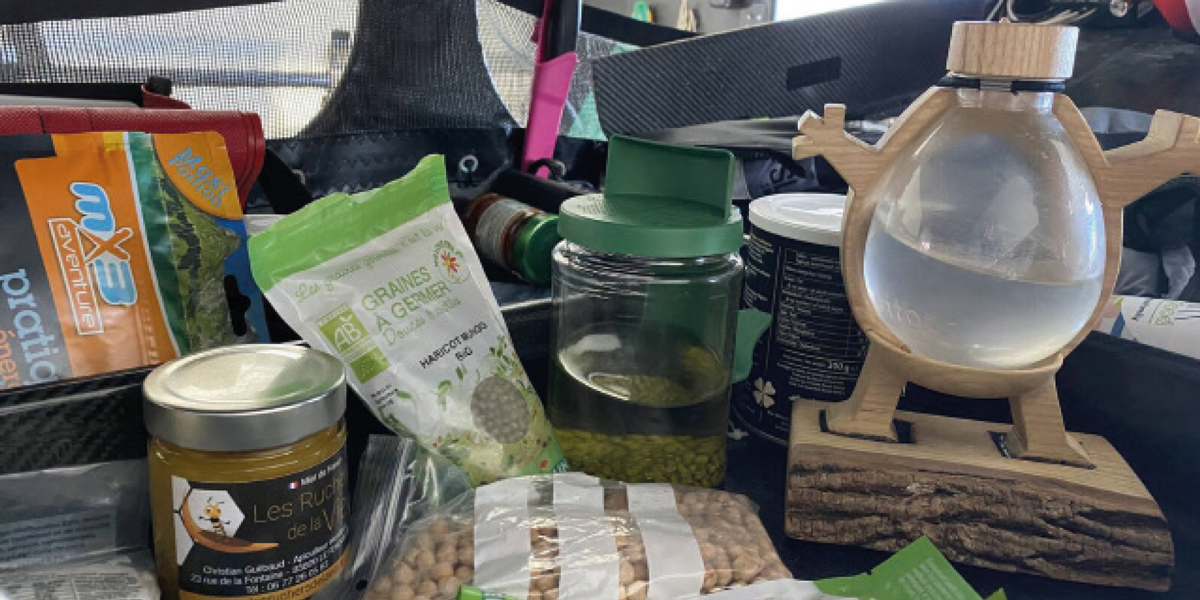Vendée Globe: drama on the high seas

Posted on Jul 28, 2022 by FEED Staff
The Vendée Globe around the world solo race is the Mount Everest of sailing competitions. It also makes for amazing sports drama in a world starved for epic sports events
Words by Neal Romanek
The Vendée Globe is one of the world’s greatest endurance events. Launched every four years from Les Sables-d’Olonne in the French Département of Vendée, it’s a solo, non-stop, around the world race that attracts sailing legends and major brands.
The competition began on 8 November 2020 and continues into 2021. The winner of the last Vendée Globe, which started in 2016, circled the Earth in a record-breaking 74 days, but the voyage can last three months. Many boats don’t even complete the race. Of the 29 skippers who began the 2016 race, only 18 finished – and that was a record. Previously, the majority of the field has had to retire. This edition’s fleet consists of 33 skippers representing nine nationalities. Six of the competitors are women, more than in any previous Vendée Globe.
Solo, around the world sailing is a notoriously dangerous feat. The Vendée Globe has seen two deaths in its history. In 1992, British skipper Nigel Burgess was lost at sea three days into the race and, during the 1996 Vendée Globe, the Argos beacon on Canadian Gerry Roufs’ boat stopped transmitting in the South Pacific. The boat washed up on the coast of Chile months later.
Structural damage to the high-performance monohull boats is common. The sea and the long days are hell on rudders, keels, masts and hulls. Then there are the collisions with UFOs (unidentified floating objects). Sometimes, these are whales, as in one case last time out (identified later with camera footage), but UFOs can often be manmade items, like floating cargo containers.
At the time of writing, high-profile competitors, Alex Thomson and Kevin Escoffier, have had to drop out due to damage. Escoffier’s boat snapped in half in rough seas, sinking in minutes. Nearby competitors diverted from their course to rescue him. He was picked up by veteran skipper Jean Le Cam within 12 hours.
This year, many boats are trialling a new collision avoidance system technology, OSCAR. The system uses mast-mounted daylight and thermal cameras, combined with AI, to alert skippers of potential obstacles along their heading. Skippers can view and record the images captured by the mast cameras and survey potential threats on a map.
Global coverage
Hervé Borde has been a fixture of the Vendée Globe’s media coverage for 30 years. His company Nefertiti Production is the official host broadcaster for the 2020-21 event.
“I know this race,” Borde says. He was executive producer in 2004, 2012, 2016 and, before that, he helped individual skippers with their coverage, starting with the second Vendée Globe in 1992.
The Vendée Globe’s departure is a major celebration. Usually, Les Sables-d’Olonne is overrun with fans and the Vendée Globe village is a hub of excitement. This time, Covid-19 has forced the village to close a week before the race. Only authorised individuals were able to wave off the skippers in person. Other fans sent personal messages to the fleet that appeared on giant screens. Nevertheless, it was still a visual spectacular and included a dramatic flight over the boats by the Patrouille de France aerobatic team, streaming the Tricolour through the sky.
Shooting the complicated race start was split into two live segments: one with the boats leaving the pontoons and one with the boats heading out to sea. Using ten cameras and one helicopter with a Cineflex, Borde’s team captured the event in 4K UHD and produced a worldwide feed in HD. Directed by Anthony Forestier, director of the Tour de France coverage, the start went out to French TV channels and 28 international TV channels and digital platforms to a total of 190 territories.
Borde says the production of the start hasn’t changed too much over the years the Vendée Globe has taken place. The technology, number of cameras and number of affiliates have all grown, but the shoot has more or less remained the same. But the possibilities in terms of covering the race itself, from the individual boats, has changed greatly over the years.
“We developed new tech that allows the sailors to easily send footage from their boats,” says Borde. “We have developed software in partnership with Ektacom that allows the sailors to have live video links with the race organisation and with broadcasters around the world.”
Broadcasters can download the Ektacom Nomade Access solution for free, which permits them live access to book slots with the skippers for live interviews at sea for the duration of the race. The cost for the installation is absorbed by the teams who pay an additional fee for the Ektacom tool. All boats are required to install some kind of high-performance live video interview solution and also are required to have a Skype-like solution as a back-up.
Every day, the Vendée Globe produces a live lunchtime show, Vendée Live, hosted by international sailing journalist Andi Robertson. It features live interviews with skippers as well as up-to-the-minute weather reports and discussions with sailing experts and members of each boat’s support crew. The live content is transported by Inmarsat satellite technology and files are exchanged using the Iridium Certus platform.
The Vendée Globe around the world solo race is the Mount Everest of sailing competitions. It also makes for amazing sports drama in a world starved for epic sports events
Words by Neal Romanek
The Vendée Globe is one of the world’s greatest endurance events. Launched every four years from Les Sables-d’Olonne in the French Département of Vendée, it’s a solo, non-stop, around the world race that attracts sailing legends and major brands.
The competition began on 8 November 2020 and continues into 2021. The winner of the last Vendée Globe, which started in 2016, circled the Earth in a record-breaking 74 days, but the voyage can last three months. Many boats don’t even complete the race. Of the 29 skippers who began the 2016 race, only 18 finished – and that was a record. Previously, the majority of the field has had to retire. This edition’s fleet consists of 33 skippers representing nine nationalities. Six of the competitors are women, more than in any previous Vendée Globe.
Solo, around the world sailing is a notoriously dangerous feat. The Vendée Globe has seen two deaths in its history. In 1992, British skipper Nigel Burgess was lost at sea three days into the race and, during the 1996 Vendée Globe, the Argos beacon on Canadian Gerry Roufs’ boat stopped transmitting in the South Pacific. The boat washed up on the coast of Chile months later.
Structural damage to the high-performance monohull boats is common. The sea and the long days are hell on rudders, keels, masts and hulls. Then there are the collisions with UFOs (unidentified floating objects). Sometimes, these are whales, as in one case last time out (identified later with camera footage), but UFOs can often be manmade items, like floating cargo containers.
At the time of writing, high-profile competitors, Alex Thomson and Kevin Escoffier, have had to drop out due to damage. Escoffier’s boat snapped in half in rough seas, sinking in minutes. Nearby competitors diverted from their course to rescue him. He was picked up by veteran skipper Jean Le Cam within 12 hours.
This year, many boats are trialling a new collision avoidance system technology, OSCAR. The system uses mast-mounted daylight and thermal cameras, combined with AI, to alert skippers of potential obstacles along their heading. Skippers can view and record the images captured by the mast cameras and survey potential threats on a map.
Global coverage
Hervé Borde has been a fixture of the Vendée Globe’s media coverage for 30 years. His company Nefertiti Production is the official host broadcaster for the 2020-21 event.
“I know this race,” Borde says. He was executive producer in 2004, 2012, 2016 and, before that, he helped individual skippers with their coverage, starting with the second Vendée Globe in 1992.
The Vendée Globe’s departure is a major celebration. Usually, Les Sables-d’Olonne is overrun with fans and the Vendée Globe village is a hub of excitement. This time, Covid-19 has forced the village to close a week before the race. Only authorised individuals were able to wave off the skippers in person. Other fans sent personal messages to the fleet that appeared on giant screens. Nevertheless, it was still a visual spectacular and included a dramatic flight over the boats by the Patrouille de France aerobatic team, streaming the Tricolour through the sky.
Shooting the complicated race start was split into two live segments: one with the boats leaving the pontoons and one with the boats heading out to sea. Using ten cameras and one helicopter with a Cineflex, Borde’s team captured the event in 4K UHD and produced a worldwide feed in HD. Directed by Anthony Forestier, director of the Tour de France coverage, the start went out to French TV channels and 28 international TV channels and digital platforms to a total of 190 territories.
Borde says the production of the start hasn’t changed too much over the years the Vendée Globe has taken place. The technology, number of cameras and number of affiliates have all grown, but the shoot has more or less remained the same. But the possibilities in terms of covering the race itself, from the individual boats, has changed greatly over the years.
“We developed new tech that allows the sailors to easily send footage from their boats,” says Borde. “We have developed software in partnership with Ektacom that allows the sailors to have live video links with the race organisation and with broadcasters around the world.”
Broadcasters can download the Ektacom Nomade Access solution for free, which permits them live access to book slots with the skippers for live interviews at sea for the duration of the race. The cost for the installation is absorbed by the teams who pay an additional fee for the Ektacom tool. All boats are required to install some kind of high-performance live video interview solution and also are required to have a Skype-like solution as a back-up.
Every day, the Vendée Globe produces a live lunchtime show, Vendée Live, hosted by international sailing journalist Andi Robertson. It features live interviews with skippers as well as up-to-the-minute weather reports and discussions with sailing experts and members of each boat’s support crew. The live content is transported by Inmarsat satellite technology and files are exchanged using the Iridium Certus platform.


Everyone onboard
Another new feature of this edition’s coverage is a multimedia server, giving broadcasters and press access to a full range of content. Previous Vendée Globes provided broadcasters content through separate interfaces. The new server, built entirely in-house, offers full access to all video, still images, graphics, documents and audio, with direct links to content and downloadability in multiple resolutions and formats.
“Our new video server has completely changed the way people are covering the Vendée Globe,” says Borde. “And the quality of footage we’re getting has improved massively since the last edition of the race.”
When skippers transmit video or stills from the boat – everything from updates on repairs, to fan greetings to selfies and pics of their dinner – they are uploaded directly to the server. The race organisation runs a quality control check of the content and each skipper’s onshore media manager has a 30-minute buffer to cancel the upload before it is made public. The same system can send footage back to the onshore crew privately, whether for technical use or other content that the team may be producing separately. When new public material appears on the server, fans can receive SMS or email notifications.
The Vendée Globe team adds branding to the videos and also produces content from the material, including 30-second daily clips from the skippers, two-minute daily highlight clips in English and French and 15-second clips for social media.
Data diving
It appears that the Vendée Globe is well-suited to a world in lockdown. First, the participants are all completely isolated from human contact – and each had to do eight days of quarantine before start day. They also carry their own TV studio with them – not necessarily the most sophisticated set-ups, but they are able to broadcast what is happening at any time, in any location. No many sports permit so much continual personal access to the competitor.
For fans, the Vendée Globe offers a full spectrum of ways to get involved. And the length of the race itself is as long as some sports seasons – it’s like an epic novel of sport.
Stats are a key element in the Vendée Globe fan experience. Meteorology is an essential component in every aspect of the race. Wind speed and direction, currents, temperature, humidity, barometric pressure and precipitation all have a profound effect on the outcome and how each skipper copes – or doesn’t. It determines how likely they are to finish, if at all.
The race website updates the standings six times a day. The rankings list updates with each participant’s speed, location and heading, distance to finish and whether or not the boat has deployed foils. Skippers are also ranked in different categories, such as Best Speed, Best Distance Covered, Longest Distance Travelled (not necessarily the leader). The rankings are fully archived. As such, fans can travel back in time to rankings from previous days. All stats are fully downloadable in an Excel doc.
GPS allows the location of every ship to be tracked from home. The website’s zoomable tracking map allows fans to see real-time, animated weather data alongside the fleet’s progress. Fans can also toggle on and off a variety of other data points on the map, including boat names, the last edition’s winning route, day/night demarcation and even the comparative positions of the concurrently running Virtual Regatta e-sailing race.
While many of us are still compelled to stay indoors, the Vendée Globe team is taking fans along on a voyage to the extremes of the Earth and the extremes of endurance sports.
This article first featured in the Winter 2020/21 issue of FEED.
Broadcast and Streaming archives
Everyone onboard
Another new feature of this edition’s coverage is a multimedia server, giving broadcasters and press access to a full range of content. Previous Vendée Globes provided broadcasters content through separate interfaces. The new server, built entirely in-house, offers full access to all video, still images, graphics, documents and audio, with direct links to content and downloadability in multiple resolutions and formats.
“Our new video server has completely changed the way people are covering the Vendée Globe,” says Borde. “And the quality of footage we’re getting has improved massively since the last edition of the race.”
When skippers transmit video or stills from the boat – everything from updates on repairs, to fan greetings to selfies and pics of their dinner – they are uploaded directly to the server. The race organisation runs a quality control check of the content and each skipper’s onshore media manager has a 30-minute buffer to cancel the upload before it is made public. The same system can send footage back to the onshore crew privately, whether for technical use or other content that the team may be producing separately. When new public material appears on the server, fans can receive SMS or email notifications.
The Vendée Globe team adds branding to the videos and also produces content from the material, including 30-second daily clips from the skippers, two-minute daily highlight clips in English and French and 15-second clips for social media.
Data diving
It appears that the Vendée Globe is well-suited to a world in lockdown. First, the participants are all completely isolated from human contact – and each had to do eight days of quarantine before start day. They also carry their own TV studio with them – not necessarily the most sophisticated set-ups, but they are able to broadcast what is happening at any time, in any location. No many sports permit so much continual personal access to the competitor.
For fans, the Vendée Globe offers a full spectrum of ways to get involved. And the length of the race itself is as long as some sports seasons – it’s like an epic novel of sport.
Stats are a key element in the Vendée Globe fan experience. Meteorology is an essential component in every aspect of the race. Wind speed and direction, currents, temperature, humidity, barometric pressure and precipitation all have a profound effect on the outcome and how each skipper copes – or doesn’t. It determines how likely they are to finish, if at all.
The race website updates the standings six times a day. The rankings list updates with each participant’s speed, location and heading, distance to finish and whether or not the boat has deployed foils. Skippers are also ranked in different categories, such as Best Speed, Best Distance Covered, Longest Distance Travelled (not necessarily the leader). The rankings are fully archived. As such, fans can travel back in time to rankings from previous days. All stats are fully downloadable in an Excel doc.
GPS allows the location of every ship to be tracked from home. The website’s zoomable tracking map allows fans to see real-time, animated weather data alongside the fleet’s progress. Fans can also toggle on and off a variety of other data points on the map, including boat names, the last edition’s winning route, day/night demarcation and even the comparative positions of the concurrently running Virtual Regatta e-sailing race.
While many of us are still compelled to stay indoors, the Vendée Globe team is taking fans along on a voyage to the extremes of the Earth and the extremes of endurance sports.
This article first featured in the Winter 2020/21 issue of FEED.
Broadcast and Streaming archives



